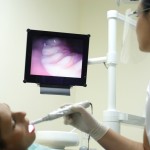
Intra-oral scanners are relatively new chair side devices that scan the patients dentitions as an alternative to conventional impression materials. The aim of this review was to assess the validity, repeatability, reproducibility, for time efficiency, and patient acceptance of full-arch intra-oral scanners.
Methods
Searches were conducted in the PubMed, Embase, Cochrane Library, Scopus, and Web of Science databases without language restrictions. Studies on full-arch digital impressions recorded intra-orally where validity, repeatability, reproducibility, time efficiency, or patient acceptance were considered. Two reviewers independently selected studies and assessed quality using the Quality Assessment of Diagnostic Accuracy Studies (QUADAS) checklist as a guide. A narrative summary of the findings was presented.
Results
- Only 8 studies reported on full-arch intraoral scans.
- 4 studies involving a total of 68 patients reported data on validity, repeatability and reproducibility of digital measurements. All 4 studies were at high risk of bias.
- Time required for digital acquisition of the full dentition was measured in six studies a trend toward the decrease in scanning times as the operator gained experience with a range of 4 -46mins reported with 4 different scanners.
- 4 studies evaluated patients’ acceptance with preference rates for scanning varying between 27-100%.
Conclusions
The authors concluded:
In only eight published studies complete-arch scans had been performed intra-orally and in just four of them data on validity, repeatability, reproducibility of digital measurements were provided. Only two of all the marketed scanners have been investigated under clinical conditions. According to the QUADAS tool, no study was adequate with regard to the sampling method, as sample collection was limited to subjects in complete permanent dentition.
Comments
Intraoral digital scanners are clearly in the early stage of their development and this is perhaps demonstrated by the dearth of studies available on validity, repeatability and reproducibility of digital measurements. As the authors note while several scanners have been commercialised for use in orthodontics only two have been tested and reported in the clinical literature. The available studies are only involve a small number of patients and are at a high risk of bias. One of the largest studies involving 100 patients assessed patients’ acceptability against impression material although they do not report which material they used. Although the authors’ have conduced a wide search for evidence it is clear from what little is available that this is a young technology and that no high quality studies have been conducted on their validity, repeatability and reproducibility. Consequently, high quality studies are needed on these aspects of this technology together with information on scanning times and patient preferences before they are introduced into clinical practice.
Links
Goracci C, Franchi L, Vichi A, Ferrari M. Accuracy, reliability, and efficiency of intraoral scanners for full-arch impressions: a systematic review of the clinical evidence. Eur J Orthod. 2015 Oct 20. pii: cjv077. [Epub ahead of print] Review. PubMed PMID: 26487391.

American Dental Association just released an accuracy study of the six leading intraoral scanners in the market: http://www.ada.org/en/publications/ada-professional-product-review-ppr/archives/2015/volume-10-issue-4/evaluation-of-the-accuracy-of-six-intraoral-scanning-devices
There are clear differences between this review and the ADA study. The ADA review focuses on single teeth and looks at research conducted in vitro. The review reported in the blog is about the evidence for the use of these scanners intra-orally for full mouth impressions.
Intraoral scanners for digital impressions https://t.co/e3ocw3QZo1
No high quality evidence on intraoral scanners for digital impressions https://t.co/e3ocw3QZo1
Review find only 4 studies on intraoral scanners for digital impressions https://t.co/e3ocw3QZo1
No data on accuracy, reliability, or efficiency of intraoral scanners for full-arch impressions https://t.co/e3ocw3QZo1
Don’t miss – Intraoral scanners for digital impressions https://t.co/e3ocw3QZo1
Intraoral Scanners for Digital Impressions https://t.co/3n2EY12B9m